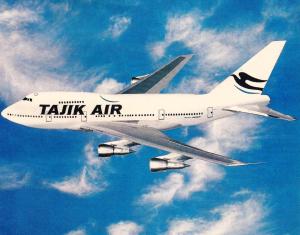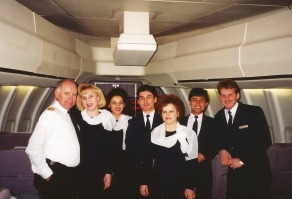Pan Am Series – Part XXXIII: Saigon
26 April 2014 Leave a comment
Pan American’s Presence in Saigon
Part 1
On 24 April 1975, Clipper Unity, a Boeing 747, departed Tan Son Nhut Airport in Saigon with 463 passengers on board, ending an over twenty year Pan American World Airways presence that started with two weekly scheduled DC-4 passenger rotations in the mid-1950’s, growing to daily 707/747 scheduled passenger operations in the 1960’s and early 1970’s, along with extensive cargo operations in support of the U.S. military, was eventually reduced to two rotations a week in the mid 1970’s and finally ended just before the fall of South Vietnam in 1975. This is the first of three stories about Pan American’s presence.
The Airport
Saigon’s Tan Son Nhut International Airport had its origins in the early 1930s, when the French colonial government constructed a small airport with unpaved runways near the village of Tan Son Nhut. By mid-1956, with U.S. aid, a 7,200-foot (2,190 m) runway had been built and the airfield became Saigon’s and South Vietnam’s principal international gateway. Between 1968 and 1974, the airport was the major base for military operations during the Vietnam War and was one of the busiest military airbases in the world.
Pan American’s Operations in Saigon
Saigon as a Pan American city first appeared in its timetable maps in the late 1940’s, but was not listed in the flight schedules or shown in the “List of Principal Offices”. In the May, 1950 timetable, a route to/from Saigon was identified as “services authorized but not operating”. In the January and April 1952 timetables, Saigon was not even on the route map. By the June 1954 timetable, two weekly rotations were being offered between Manila-Saigon-Singapore with DC-4 equipment. The flights linked at Manila with Pan American’s San Francisco service Below is the map from a 1948 timetable and the Pacific services in the 1954 timetable:

In the September 1957 timetable, the Manila-Saigon-Singapore service was increased to three rotations weekly with DC-6B equipment. These flights linked to Pan American’s to San Francisco and Los Angeles services at Manila. In the April 1959 timetable, the service was increased to five rotations weekly with both DC-6B and Boeing 377 Stratocruisers. By the September 1961 timetable, two weekly rotations were offered on the Honolulu-Guam-Manila-Saigon-Singapore-Djakarta route with Boeing 707’s or DC-8’s. In addition the eastbound round-the-world flight number 2 made a weekly stop.
In the April 1965 timetable, three weekly rotations were offered between Honolulu and Saigon (with both intermediate and beyond points) as well as the weekly eastbound round-the-world flight 2. All-cargo freighters were shown operating three rotations weekly in the timetable as well. By the September 1966 timetable, the passenger operations were up to four rotations weekly plus the once-a-week eastbound round-the-world flight. The all-cargo service was shown as a daily operation, although some all-cargo flights required a minimum revenue load to be “flag-stopped” . By the September 1969 timetable, the number of rotations was increased to five and with extensive cargo operations.
In the January 1971, Pan American offered a daily rotation with Boeing 707 aircraft as well as daily all-cargo services. By late 1973, Pan American severely reduced its Saigon service to a twice weekly rotation and three weekly all-cargo operations. After April 1975, there was no Pan American presence in Saigon.
The End of the Pan American Era in Saigon
Al Topping was Pan American’s last Station Manager at Saigon and organized the airline’s last ever departure from Ton Son Nhut Airport. His story was captured in a made-for-TV movie, Last Flight Out, starring James Earl Jones as Topping and Richard Crenna as Clipper Unity’s pilot Dan Hood. Topping’s story also appears in Pan American World Airways – Aviation History Through the Words of its People. Below is an excerpt:
“[In] November of 1972, I was in charge of the Pan Am operation in South Vietnam. * * * Saigon was very hot, very humid, very noisy, and due to the tens of thousands of motor bikes (the primary means of transportation) the air was polluted. The international arrivals area at [Saigon’s] airport had dirt floors and no air conditioning. Downtown was a bustling crowded city with a variety of shops, restaurants, an open / active black market, street money changers, prostitutes and beggars roaming the streets holding babies—many of them scared and crippled by napalm.
“As for the war, there were signs of it everywhere. A tank guarded the entrance to the airport, and heavily armed troops guarded every government building. The most telling of all were the sounds of war. Every night one could hear muffled booms of shelling off in the distance. Nevertheless the war was supposedly winding down and peace talks were on-going in Paris. A peace agreement was finally reached and by June of 1973 the last American combat troops departed Vietnam. The 10,000 day war was finally over. So we thought. Optimism was in the air. The government began promoting tourism and encouraging foreign investments. Back in Washington, DC the United States Congress voted to virtually terminate all military aid to Vietnam. The South Vietnamese were now on their own.
“Approximately 18 months passed and the political landscape of South Vietnam began to dramatically change. Huge chunks of South Vietnam were taken over by advancing North Vietnamese troops. Cities, provinces and villages were falling with hardly a shot being fired. It was becoming obvious to me that North Vietnam had Saigon in its cross-hairs. In early April 1975, panic was in the air.
“Various American companies began sending some of their employees to places like Hong Kong and Singapore. As the situation deteriorated I convinced Pan Am to commit to evacuating all of our local staff and their immediate families. But it was up to me to come up with a plan for the actual evacuation, a workable plan that would not endanger lives. It was only later that I realized I was embarking on a decision-making process I would never forget.
“Tension and suspense engulfed us as evacuation plans were being made. There were some surprises. When I asked our personnel manager for a listing of all 61 employees and their immediate family members, I was presented with a list of over 700 names. In the Asian culture, the immediate family is the extended family. Now what, I wondered? For the first time, I saw the enormity of the situation. Lives were at stake. I held some emotional, gut-wrenching meetings with our department heads. It was necessary to review again and again the company commitment of evacuating our employees and their ‘immediate families’. It was extremely difficult to convince them of the differences in interpretations of an immediate family. In the end they would have to make the final decision as to who goes and who stays. So it was now a matter of freedom for some and unknown consequences for others. Once the decisions were made I had a list of 315 employees and their family members. One more major challenge was lurking.
“Although the government of South Vietnam was rapidly deteriorating, they were still in charge. A Vietnamese citizen could not leave the country without proper documentation. Under normal circumstances it may take two to three months for Vietnamese to obtain a passport and visa. However, we had little time left. We needed those documents in a matter of days. In the past, I had witnessed hundreds of orphans being expeditiously evacuated to the U.S. for adoption. I soon realized that this may be our only way out.
“Our personnel manager spent countless hours at the Office of the Ministry of Interior to obtain the required documentation for adoption. My staff prepared these stacks of legal documents for my signature that would also permit our Vietnamese employees to leave the country. In effect, the documents I signed said I was adopting more than 300 people, that I would be responsible for their well-being in the United States. It worked!
“The situation in Saigon was now in panic mode. In order to avoid further chaos the final date and time of Pan Am’s LAST FLIGHT OUT was kept secret until the night before. It was to be Thursday April 24, 1975. Most of our employees and their families spent the night in the back rooms of our downtown ticket office. Three buses brought them to the airport that morning. At the airport checkpoint armed troops boarded the buses to check the documentation. The tension in the air on those buses defied description.
“The aircraft was Clipper Unity N653PA, a Boeing 747. After cramming 463 souls on board into a cabin configured with 375 seats, the LAST FLIGHT OUT lifted off the runway on the designated date. Many of the passengers doubled up in one seat. Others stood in the aisles, sat on the floor or found space in the lavatories.
“The flight’s departure, however, had not been assured. Shortly beforehand, the Federal Aviation Administration had banned U.S. commercial flights into Saigon. It was not until high-level U.S. officials had designated our flight as a U.S. government charter that the jumbo jet could fly into Saigon to take us out. When Capt. Bob Berg finally received take-off clearance and we began our take-off roll, my heart was pounding like a bass drum. The tension was overwhelming until we cleared the coastline and I could see the fleet of American warships in the South China Sea below us. At that point I said, thank God we made it.”
Pan American’s involvement in Saigon extended beyond its scheduled passenger and cargo operations. In the next two postings will be stories about how the people of Pan American went out of their way to help their fellow human beings in desperate and difficult circumstances.
For additional information about Pan American World Airways:
To learn more about the history of this pioneering airline, click on the title below for preview of
Pan American World Airways – Images of a Great Airline Second Edition.
This book is available on eBay .
Another excellent book is Pan Am – Personal Tributes to a Global Aviation Pioneer, which was published to commemorate the 90th Anniversary of Pan Am’s founding. It contains more than 80 stories written by former Pan Am employees and international media friends who had personal experience with many of Pan Am’s key events during its history. It is the perfect companion to Pan American World Airways – Images of a Great Airline Second Edition and can be purchased on Amazon.
Preview Pan American World Airways – Aviation History Through the Words of its People, which is available on Amazon.
For further information about the history of Pan American World Airways, visit: Pan Am Historical Foundation









































Recent Comments